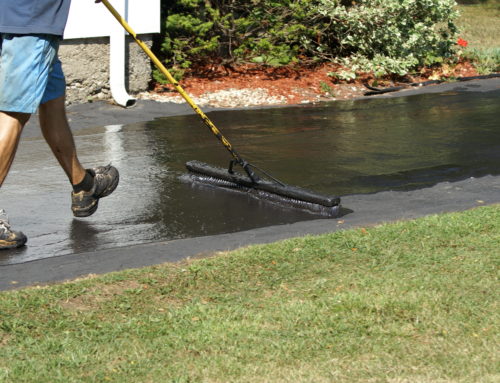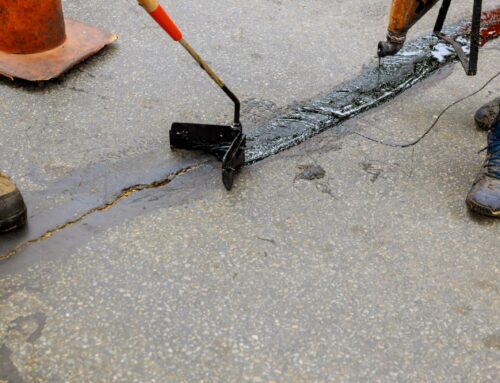his time on the Sunrise Asphalt blog we wanted to give you a one stop shop for industry terms and jargon — words you will come across while looking into asphalt paving contractors and our services. Now, any contractor worth their salt will be happy to explain each and every question, but if you want to better understand blog posts, brochures, or are just looking for a quick definition – hopefully this resource serves you well!
Alligator Cracks
Interconnected cracks across an asphalt surface forming a series of small squares that resemble an alligator’s skin.
Aggregate
A hard inert material made up of many different minerals such as sand, gravel, slag, or crushed stone, used in pavement applications either by itself or for mixing with asphalt binder.
Aggregate Types
These are the different types of aggregates and the sieves that catch them.
- Coarse Aggregate: Aggregate particles caught on the 2.36 mm (No. 8) sieve.
- Fine Aggregate: Aggregate particles that pass through the 2.36 mm (No. 8) sieve and are caught on the 0.075 mm (No. 200) sieve.
Aggregate Gradation
The particle size distribution from the largest through finest materials.
Aggregate Gradation Types
- Coarse-Graded Aggregate: Aggregate having a continuous grading in sizes of particles from coarse through fine with more material larger than the primary control sieve.
- Dense-Graded Aggregate: Aggregate that has a particle size distribution such that when it is compacted, the resulting voids between the aggregate particles, expressed as a percentage of the total space occupied by the material, are relatively small.
- Fine-Graded Aggregate: Aggregate having a continuous grading in sizes of particles from coarse through fine with more material smaller than the primary control sieve.
- Gap-Graded Aggregate: Aggregate consisting of larger and finer particles but little or no particles in the middle of the gradation band creating a “gap”.
- Open-Graded Aggregate: Aggregate containing little or no mineral filler and in which the void space in the compacted aggregate is relatively large, usually 10% or more.
- Well-Graded Aggregate: Aggregate with relatively uniform proportions from the maximum size down to filler with the object of obtaining an asphalt mix with a controlled void content and high stability. Well-graded aggregate is also known as uniformly-graded aggregate.
Aggregate Spreaders
Machines used for spreading aggregate evenly at a uniform rate on a surface.
Aggregate Storage Bins
Bins that store the necessary aggregate sizes and feed them to the dryer at the necessary rate and proportions for the finished mix.
Aggregate Trucks
Special trucks equipped with hydraulics to dump aggregate into an attached spreader or storage area.
Asphalt Binder
Asphalt cement that is classified according to the Standard Specification for Performance Graded Asphalt Binder, AASHTO Designation MP1. It can be either unmodified or modified asphalt cement, as long as it complies with the specifications.
Asphalt Concrete
High quality hot mixture asphalt and high quality aggregate materials compacted into a solid sturdy surface, great for driving! Also known as just plain asphalt.
Asphalt Distributor
A truck or a trailer with an insulated tank, heating system and distribution system. The distributor applies asphalt to a surface at a uniform rate.
Asphalt Emulsion
A mixture of asphalt binder and water that contains a small amount of an emulsifying agent. Emulsified asphalt droplets may be of either the anionic (negative charge), cationic (positive charge) or nonionic (neutral).
Asphalt Emulsion Mix (Cold)
A mixture of unheated mineral aggregate and emulsified (or cutback) asphalt binder. It can be plant-mixed or mixed in-place.
Asphalt Emulsion Mix (Warm)
A mixture of asphalt emulsion and mineral aggregate usually prepared in a conventional hot mix asphalt plant at a temperature less than 95°C (200°F). It is spread and compacted at a temperature above 65°C (150°F).
Asphalt Emulsion Slurry Seal
A mix of emulsified (a fine dispersion of minute droplets of one liquid in another in which it is not soluble) water, asphalt, aggregate, and mineral fillers produced to a slurry consistency put on to a pavement surface as a sealer.
Asphalt Fog Seal
Asphalt emulsion diluted with water, lightly applied to renew older asphalt, sealing small cracks and gaps.
Asphalt Overlay
A layer of asphalt and aggregate mixture laid over an existing pavement structure to restore its look and performance. Generally includes a leveling course/pavement milling to correct the contour of the older surface, and then followed by other courses to provide the needed thickness.
Asphalt Pavement
Asphalt is the building block of all we do here! Aggregate and asphalt compacted together over supporting layers of gravel, crushed stone, etc. All together it makes asphalt pavement!
Bleeding Asphalt
A film of asphalt on the surface of the pavement caused by an upward movement of asphalt from inside the layers. Sometimes known as flushing asphalt.
Blow-Up
The buckling or shattering of pavement, usually occurring at joints or transverse cracks.
Chip Seal
Asphalt emulsion applied to existing asphalt pavement for asphalt preservation and skid resistance.
Crack
A simple separation in the pavement. Could be caused by natural causes such as weather, traffic, or caused by underlying problems in the base of the pavement.
Deflection
The movement downward of pavement due to heavy load on the surface.
Depressions
Low areas or divots of limited size. May or may not be accompanied by cracking.
Disintegration
The breaking up of pavement from its original shape and form.
Fault
A difference in elevation of two slabs at a joint or crack.
Full-Depth Asphalt Pavement
Asphalt pavement structure that uses asphalt mixtures for all layers above the subgrade or improved subgrade.
Hot Mix Asphalt
Asphalt cement and aggregate mixed together at a hot temperature.
Mixed-in-Place (Road-Mix)
Asphalt layer made by mixing aggregate and emulsified asphalt or cutback at the road site using a traveling plant, motor graders, and other special equipment.
Plant Mix
Any mixture produced in an asphalt mixing plant. Made up of asphalt binder and mineral aggregate.
Polished Aggregate
Aggregate particles in a pavement surface with edges that have been rounded and surfaces polished smooth by traffic.
Potholes
The bane of our existence! But also, any bowl (or pot!)-shaped hole of varying sizes in the pavement.
Raveling
The progressive separation of aggregate particles in a pavement from the surface downward or from the edges inward.
Recycling
Reusing a material (usually after some sort of process) after it has already served its original intended purpose.
For asphalt that means recycling the old torn up asphalt and making new recycled mixes.
Reflection Cracks
Cracks in asphalt overlay layers that mirror, or reflect, the crack pattern in the pavement structure underneath.
Rutting
Channelized depressions that may develop in asphalt pavement, usually where wheels heavily traffic.
Seal Coat
A thin asphalt surface treatment used to waterproof and improve the texture of an asphalt surface.
Skid Hazard
Any condition that contributes to making a pavement slippery.
Slippage Cracks
Cracks, sometimes crescent-shaped, that point in the direction of the thrust of the wheels on the pavement. Caused by lack of bond between two layers of pavement.
Spalling
The breaking or chipping of pavement at joints, cracks, or edges.
Upheaval
The upward displacement of pavement due to swelling of the subgrade or some portion of the pavement structure.




